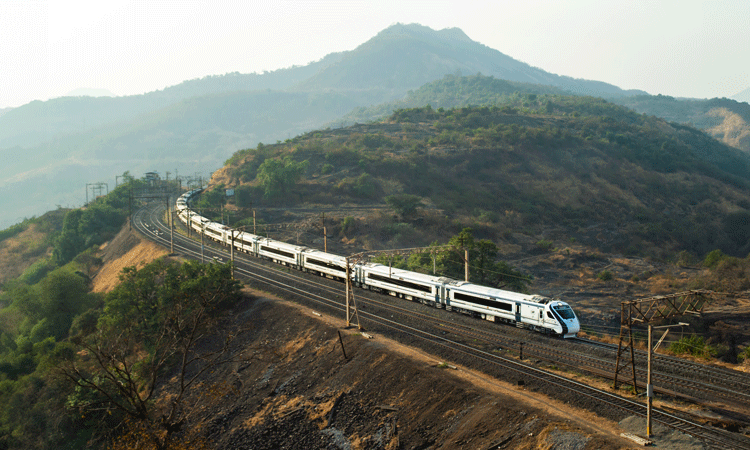Rationalising policy choices and their impact on railway modernisation: A perspective on the Vande Bharat project
Posted: 25 November 2024 | Chitresh Shrivastva, Dr Abhilasha Sharma | No comments yet
Chitresh Shrivastva, Independent Railway Policy Analyst & Dr Abhilasha Sharma, Assistant Professor at St. Wilfred College, Jaipur discuss India’s Vande Bharat project.


c: Pranit Gawand
The Indian Railways is a 167 year old organisation which enjoys a global reputation being counted amongst the largest railway networks globally and the South Asian region. The decades following 1960 onwards have been a testimony to some massive transitions witnessed by the rail as the industry opened up to strengthening their network and revamping their operational speeds. India too followed the suit with the first long-distance high‑speed service dedicated to the nation on 3 March 1969 when the first Rajdhani service connecting the state capital Kolkata to India’s national capital New Delhi chugged out of the station, paving way for future projects aimed at speeding up modernisation of the Indian railway network. This is an ongoing process which sees no end, given the dynamism exhibited by rail in the global arena.
India’s membership in the International Union of Railways amongst the active members can also be attributed to the reasons behind its changing outlook towards the idea of railways from a mere colonial instrument to an important driver of the economy. On a similar note, India’s impending high-speed projects are also symbolic of its emerging competitive spirit and the determination to mark its place amongst the global high-speed rail networks. As India awaits its first global high-speed rail corridor, it is important to note the progress that India has been making in exploring the potential of semi high-speed rail corridors at the domestic level. The Train 18 or the Vande Bharat Express project is an exemplary example of the in-house modernisation project.
Despite the traction that the project gained in its early days of conceptualisation, of late it is being gradually phased out through poor policymaking and the rigid attitude of the railway bureaucracy to adopting and experimenting alternative technologies, while putting high stakes in economically sensitive projects such as the Mumbai – Ahmedabad High-Speed Rail Corridor. This is saddled with uncertainty given the socio-economic concerns surrounding the project ranging from resettlement of the affected groups to adequate compensation to the farming community, who have been greatly impacted by the project.
As we stare at the solutions available with the existing infrastructure and technology available at our disposal, it is unfortunate to note that the Vande Bharat project, touted as a key to improving India’s position in the global railway community, has gradually withered away. Here, we discuss the potential outcomes that the project has to offer in the greater interests of India’s ambitious railway modernisation project.
The idea of Train 18: opportunities and challenges
February 15 2020, has been a watershed moment in the history of railways with India’s first trainset, christened Train-18 or the Vande Bharat Express, inaugurated on the New Delhi – Varanasi route. The cost of manufacturing at just INR 100 crores and induction of modern technologies such as regenerative braking became a major attraction not just for India, but the international community at large.
Train 18 is not the first time India has attempted to exploit its current infrastructure to optimise the operational speeds of trains. In the past, India’s successful trials with Gatiman and Tejas fleet have pointed out the long-term benefits of improving connectivity between cities of tourist importance, paving the way for the Train 18 project with a new approach to how India travels. In a tug of war between aviation and the railways, Train-18 could emerge as a major competitor to the aviation’s UDAN scheme by not just providing seamless connectivity to smaller cities, but also making ‘high‑speed’ trains accessible to the middle strata of the society deprived of an airport or lack of access to aviation attributed to its fare dynamics. When looked at from the sustainability point of view, the railways are in a much better position compared to the airlines, given the budgetary support, an essential back up to help the railways shape its modernisation approach with the changing demands of rail travel.
It is an economically viable option compared to the bullet train project, given the train’s ability to operate at semi‑high‑speeds on the existing infrastructure, much of which is being strengthened to help meet the objectives of Mission Raftaar envisioned by the government. The project, unfortunately, has been a victim of poor policy choices with the railways being sceptical of the success rate of the Train-18 project. This is further supplemented by rail progressing at a disappointing pace on projects crucial to catalysing the spread of Train-18, with 3,479 kilometres of the track yet to undergo a gauge conversion. Similarly, India’s ambitious yet capital intensive project is yet to be complete to help expand the choices of intercity travel by rail through the induction of Vande Bharat fleet of trains.
While these can be inferred as possible opportunities capable of being executed with the infrastructure execution on a war footing basis, it is also the thin line of difference in the fares of Vande Bharat and the aviation players operating on the same sector, marked by a humungous variation in anticipated travel time. A flight journey between New Delhi and Varanasi would take 1 hour and 35 minutes, compared to the eight hours taken by Vande Bharat Express (Train 18) to cover the same distance.
The larger picture of the Vande Bharat project for rail India’s intention to compete with the developed railway networks globally is of noble character. What hinders its progress is the overshadowing of a rigid railway bureaucracy with a superiority complex holding them back from accepting the emergence of trainsets as the current instrument of railway modernisation. The quest for high-speed rail in India has its own political and diplomatic interests, putting at stake the economies of scale in the quest to fulfil its quest of conquering the country through capital intensive yet saddled with uncertain returns on investment, endangering the soundness of the economic functioning of railways. The Vande Bharat project envisioned a change in approach to railway modernisation, which must be accepted for a proactive engagement in exploring economically viable options while also exploring high-end projects with a long gestation period, such as the bullet train. Indigenisation, therefore, is the key to improving a country’s stand in the global community, and the Train-18 project is the key to building a strong and positive image in the worldwide railway community.


Chitresh Shrivastva is currently associated with the Department of Media Studies, CHRIST (Deemed to be University), Bengaluru, India as a guest faculty and is an independent railway policy analyst and writer on domestic and global railway policies.


Issue
Related topics
High-Speed Rail, Infrastructure Developments, Regulation & Legislation, Sustainability/Decarbonisation








